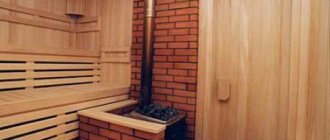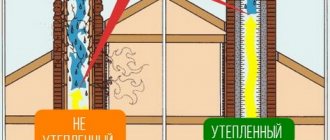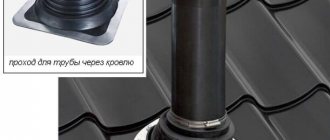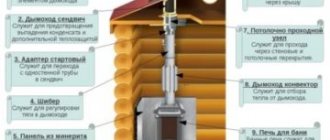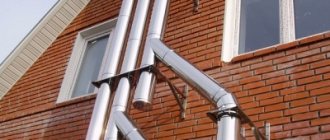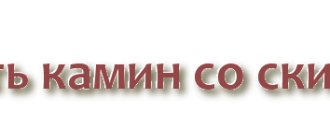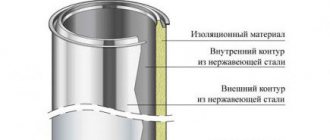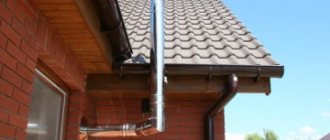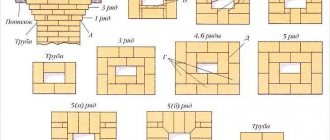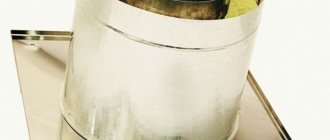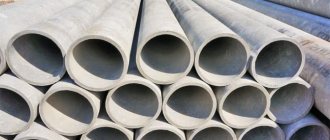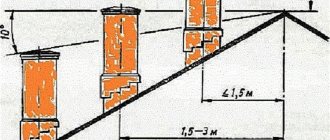10/25/2017 5872 Pechnik (Moscow) A horizontal chimney, in its structure, differs from the classic vertical structures that we are used to seeing. Coaxial type systems are most often used and installed, since they are easy to install (it is enough to simply drill a hole of a suitable diameter in the wall, insert and secure the pipe, and seal all gaps). By watching the video in this article and reading the selected information, you will learn more about what such exhaust systems are.
What is it and why is it needed?
Horizontal chimneys are sections of the chimney parallel to the floor, in one form or another passing between the stove and the exit to the roof. Performed in three types:
- In the form of a branch from the main one. The maximum length of the “lying” part is 1 m;
- Complete, with a minimum height of vertical pipe sections. Exited to the street through a hole in the wall of the house;
- Snake (only in brick version).
The working surface area of a horizontal chimney is many times larger than that of a conventional one.
In what cases is installation necessary?
- The boiler or furnace should be connected to an outlet located far away. There are situations when, for certain reasons, it is impossible to install a vertical pipe in a room. In these cases, it is taken outside the room and connected to the stove using the above-mentioned pipeline;
- The stove (boiler) has a low heat transfer rate, it is less than what is required for the heated area, and cannot cope with providing heat for the entire room. Here the horizontal section of the pipe acts as a kind of battery;
- If the heat source is not connected to coolants. This is especially true for a stone (brick) stove, which transfers heat inside the room due to the cooling of the masonry. In this case, the use of multi-turn chimneys (snakes) is most justified.
What is the difference from a coaxial chimney
A coaxial chimney is a “two-layer” system in which a smaller pipe is placed inside a larger pipe. One end of this structure is connected to the heating boiler, and the other is led outside.
The internal (thin) part serves to remove combustion products. External - provides an influx of fresh air from the street to the flame.
Passing over the inner pipe, the cold air heats up, the boiler does not waste energy heating it, and its efficiency increases.
The main differences between horizontal and coaxial chimneys:
- Design
Coaxial - two pipes, horizontal - one pipe or channel, with a certain number of bends;
- Functions
A horizontal chimney increases the area of the coolant and removes combustion products. Coaxial provides the fire with oxygen, removes smoke and increases the efficiency of the boiler;
- Location
Coaxial can be positioned both horizontally and vertically.
Which boiler/stove is suitable for a horizontal chimney?
Chimneys of this type, made in the form of a separate metal pipe, can only work with boilers equipped with forced draft. Otherwise, the exit of exhaust gases, especially over a long section, will be difficult. This is dangerous - the likelihood of poisoning from combustion products is too high.
It makes no sense to install horizontal chimneys for gas or solid fuel boilers that provide heat to radiators and other coolants.
Another thing is a stove, the heat source of which is heated bricks. Here, the device of a multi-turn smoke pipe increases the efficiency of the heater several times.
Multi-turn chimneys, in turn, are horizontal and vertical. For vertical ones, the main channels are located vertically, and the heating of such a chimney is uneven. Another thing is the horizontal option.
Requirements for the parameters of horizontal chimneys
A brick horizontal chimney operates on natural draft. To determine the parameters of the chimney, it is necessary to calculate the optimal cross-section of the pipe for cooling gases when passing one meter.
We recommend that you read: Using wall brackets to fix the chimney pipe
Estimated indicators are taken taking into account the following indicators:
- for self-drafting, the gas pressure in the pipe must be at least 1.34 Pa; a pressure of 4 Pa per 1 meter is considered normal;
- the total height of the pipe from the furnace grate cannot be less than 5 meters;
- the temperature of the gases at the entrance to the pipe is about 200 degrees, at the outlet – about 145 degrees;
- the average speed of smoke movement is from 2 m per second.
To calculate the diameter of the internal section of the pipe, indicators of the volume of fuel burned per hour are taken.
Calculations are carried out in units that are multiples of the size of a standard stove brick:
- square section measuring 260x260 mm (whole brick);
- rectangular section 260x130 mm (a whole brick per half brick);
- square section 130x130 (narrow chimney for half a brick).
A horizontal chimney that is too wide will lead to overcooling of gases and slow down their release.
A large amount of condensation will form in a cold pipe, and soot will settle on the walls. The result of a chimney that is too wide will be its rapid clogging and destruction of the masonry.
A narrow chimney will increase the intensity of fuel combustion, which will lead to overheating and cracking of the pipe. In addition, with a narrow pipe you will not be heating the room, but the street.
Advantages and disadvantages
The advantages of a horizontal chimney are that it undoubtedly increases the heat output of the stove. The smallest boiler with the help of this type of chimney is able to maintain the temperature even in a large room.
In addition to the obvious advantages, the horizontal pipeline has a number of disadvantages. These include:
- Difficulty of installation;
- The appearance of turbulence;
- Soot.
How to deal with the last two factors?
Swirl
Air microfunnels appear as a result of temperature differences and masonry features. Occurring in the inner sharp corners of the snake, vortices greatly complicate traction.
There is only one way to combat turbulence - mechanically smoothing out the sharp corners of the chimney.
Soot
The more bends, the more places for soot to settle. You can fight it in two ways:
- Install metal doors for cleaning. The method is not complicated, but due to the difference in heating of metal and brick, it significantly reduces the efficiency of the chimney;
- Provide knockout bricks in the design. This is more complicated, but reduces efficiency less
If there is a stove, there will be a chimney
Smoke hole of the stove.
The figure shows a part of the stove for which it is necessary to install a horizontal chimney.
As mentioned earlier, we must comply with all parameters of the dimensions of the internal section. If there is not enough experience in this kind of work, then you can build a pattern of the appropriate size. With its help, you can successfully control the entire process of laying bricks.
As previously mentioned, the cross-sectional size of the inside of our chimney will be 125x125x140 mm.
Setting up a horizontal channel
- To do this, we lay two rows of bricks in such a way that we get a horizontal chimney channel. The figure makes it clear how to do this. The bricks are laid in the usual way for brickwork.
- The only thing that is required is strict adherence to the thickness of the seams. Since in an ordinary brick wall a difference of a few millimeters does not play a big role, in a chimney this difference will lead to a change in the internal cross-section of the chimney.
- Therefore, when laying each brick, carefully check and adjust the thickness of the seam and the horizontalness of the laying. This can be done using a building level.
Horizontal smoke channel (section).
If necessary, the brick is knocked down with a hammer with a rubber tip or an ordinary hammer with a wooden backing. We remind you that our seam thickness is 3 mm .
Preparation for overlapping
The chimney channel is ready. Overlapping needs to be done. For this we will prepare a channel. We lay another row according to the pattern shown in the figure.
How to lay it out of brick?
Rules for installing a horizontal chimney
Building a fireplace with your own hands is not an easy process, and putting together a snake chimney is much more difficult than assembling a metal chimney.
To properly make a chimney, you must follow the following rules:
- The cross-section must be the same along the entire length;
- Sharp corners inside the chimney must be minimized;
- The inner surface should be as smooth as possible.
The fewer sharp corners, the less likely it is for turbulence to occur and, therefore, the better the traction.
Scheme and drawing
The dimensions of a standard brick are 250x120x65mm, therefore half a brick is 125mm in length. To create one channel, you should lay out 2 rows 65 + 65 mm = 130 mm. To this size it is necessary to add the thickness of the mortar layer.
The resulting chimney should have a design cross-section of 140x125x125mm. Maintaining dimensions is very important.
Step-by-step action plan
- To maintain the dimensions, a novice craftsman should use a special pattern, and no special calculations are required here. The required size of a standard chimney, as you remember, should be 125x125x140mm;
- We lay out the bricks in 2 rows to form a channel;
- The thickness of the seams must be strictly observed. Even a minimal deviation leads to a change in the size of the section. You can control the thickness of the seam using a building level;
- If necessary, the brick is knocked down with a special hammer with a wooden or rubber tip;
- Once the channel is ready, it is necessary to begin blocking. We lay another row of bricks along one side of the channel, as in the figure:
- We carefully remove the entire solution. Internal seams must be filled entirely with mortar;
- Laying floor bricks requires some skill.
We apply the brick without mortar to the structure, thus understanding where to attach it. Using a grinder, we round off the sharp corners that will be located inside the chimney. If necessary, cut the brick to size.
- We apply the solution to the parts where the brick comes into contact with the walls of the finished chimney and firmly attach the brick to the structure;
- When laying the last brick into the ceiling, you need to check the size of the vertical turn. If necessary, it can be trimmed.
Features of masonry
It is important that the thickness of the seams does not exceed 5 mm. It is better if the stove maker can maintain a thickness of no more than 3 mm. An increase in the parameter leads to a decrease in the internal dimensions of the pipe. During work, the horizontalness of the masonry is constantly monitored using a building level. A rubber hammer is used to knock down the brick. It is forbidden to knock bricks from top to bottom.
Overlapping the horizontal channel is done in the following sequence:
- One side of the channel should be higher by one brick laying. This will ensure that it is positioned in a bed on the side with a lower height and end-to-end with the opposite side.
- The prepared brick is laid on the lower wall so that its butt side is flush with the opposite wall. This is a brick fitting, which is mandatory.
- Then the mortar is placed in an even layer on the bonded side of the brick and on the lower wall of the channel. The brick is pressed, and the mixture that comes out of the seams is immediately removed.
- It should be remembered that the last brick must have rounded and polished corners on the bottom side. It is better to process them directly during laying, and if this is done in advance, the exact number of such bricks should be calculated. The next channel is arranged in the opposite direction.
Requirements for horizontal chimneys
The corners inside the channel lead to turbulence of gases, and soot settles on its walls. Chimneys of this design are characterized by the highest degree of soot formation, so their internal surface should be as smooth as possible. The channel cross-section should not change throughout its entire length. For masonry, only refractory bricks and mortar are used, the characteristics of which correspond to the following parameters:
- gas-tight structure,
- maintaining tightness,
- resistance to mechanical loads,
- resistance to condensate and its acids.
The horizontal part of the chimney is installed in heating and cooking furnaces, in which the design provides for a drying chamber. It is its location above the horizontal channels that provides optimal conditions for drying. Also, this type of chimney is the main one in the design of drying ovens. It should be noted that heating units of this design are rarely installed, since the work is considered complex and requires experience. The weight of such stoves is the largest compared to other options.
Service
How to clean such a chimney?
To clean a horizontal chimney, it is necessary to provide either special doors or areas with knockout bricks. Without these technological holes, it is impossible to clean the snake chimney.
Craftsmen advise periodically heating the stoves with dry aspen firewood and potato peelings.
These methods are not a panacea, but a good way to prevent soot formation.
